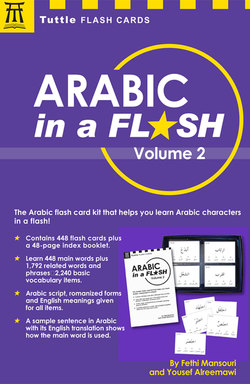Читать книгу Arabic in a Flash Kit Ebook Volume 2 - Yousef Alreemawi - Страница 5
На сайте Литреса книга снята с продажи.
ОглавлениеIntroduction
Arabic script in its current form dates back to at least 200AD, but its related Aramaic goes back to 900 BC. The language acquired a divine status when the Koran was revealed to Prophet Mohammed in 610AD. Since then it became an important language not only to Arabs but also to millions of Muslims in Africa, Asia and Europe.
Arabic is today the native language of over 250 million people, thus ranking as one of the most widespread world languages after Chinese, English, Spanish and Hindi. There are many national and regional varieties of spoken Arabic, such as Egyptian, Iraqi, Tunisian, Moroccan and Lebanese, but the language presented in these Flash Cards is Modern Standard Arabic, understood by all Arabic speakers and used throughout the Arab world in most written and broadcast material.
Arabic script is written from right to left. It is based on eighteen different letter forms derived from the script originally used to represent the Aramaic language of ancient West Asia. In the developed Arabic script these letters vary in appearance according to their connection with the letters before and after them. Eight of the letters may be modified by marks above or below them in order to represent sounds not occurring in Aramaic, resulting in the complete Arabic alphabet of 28 letters (the list excludes short vowels and the glottal stop—hamza—as these don't represent strong consonantal letters).
This is the second volume of the Arabic Flash Cards series. The first volume of the Flash Cards (448 cards) included basic communicative as well as some of the most common verbs and their related derivatives. This second volume is divided thematically into the following sections dealing with:
• Cards 449 to 496 — basic vocabulary
• Cards 497 to 555 — economic and employment
• Cards 556 to 618 — health feelings and emotions
• Cards 619 to 697 — social, political and legal
• Cards 698 to 725 — travel and leisure
• Cards 726 to 760 — various daily activities
• Cards 761 to 896 — general communicative vocabulary
Arabic script and pronunciation
Arabic script is written from right to left and has many artistic variations that produce beautiful calligraphy in the same way the Chinese language does. Arabic calligraphy has served as a form of decoration particularly in mosques where images of humans and animals are prohibited.
Arabic letters can be divided into two types: those known as connectors (i.e. other letters can be attached to it), and non-connectors (cannot be attached to other letters). Also, Arabic letters may change according to where they occur in the word (initial, medial or final).
For non-native speakers, some Arabic letters such as glottal fricatives and uvular stops are a little strange and can be challenging to pronounce. Therefore, in these Flash Cards every Arabic word or phrase is spelt out in the Roman alphabet using a conventional transliterating system based largely on the International Phonetic Association symbols. A guide to the pronunciation of these Romanized forms is given on the page 4.
